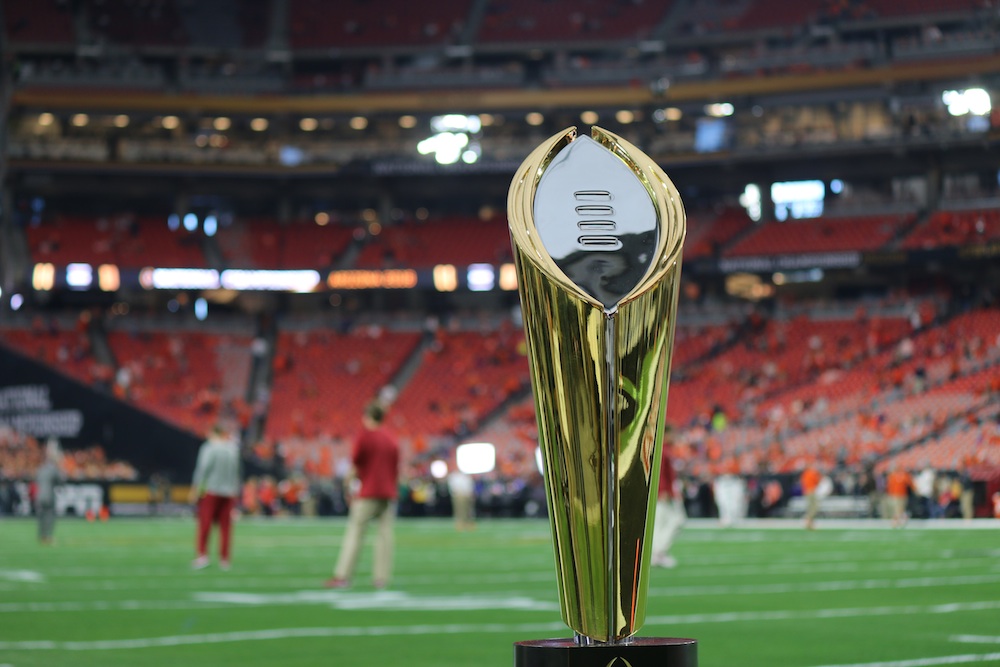Kirk Schulz didn’t take the loss hard. Washington State’s president pitched the College Football Playoff’s governing board last week on granting permanent Power Five status to the Pac-12 even though the conference will consist of just two schools, WSU and Oregon State, as of next season.
Schulz made his case along with OSU’s president Jayathi Murthy — a joint proposal that received the CFP board’s full attention.
“There wasn’t a great deal of support,” Schulz told the Hotline. “One of the reasons given was the (future revenue model) hasn’t been determined yet. It’s hard to discuss distributions beyond the next couple years. But we appreciated the opportunity to make the pitch.”
A member of the CFP board himself, Schulz did not seem frustrated by the tepid response from his peers. Nobody expected a two-team conference to be given the same status as the four massive leagues that will sprout next fall.
But when the topic turned to the CFP’s broader direction, Schulz seemed ready to sound an alarm.
If you think the NCAA is screwed up with all the legal mayhem and transfer portal madness, well, the playoff isn’t far behind. Schulz agreed with the description often used in the media — that the jewel of college football is “a mess.”
He offered two examples of the roiling waters:
*** Internal communication
The CFP has a tiered governance structure: The 10 Football Bowl Subdivision commissioners and Notre Dame’s athletic director form the management committee; one president/chancellor from each conference and Notre Dame’s president form the board of managers.
The committee creates policy, but the board must approve all major proposals and changes.
“The commissioners meet to discuss the playoff on a regular basis,” Schulz said. “Every couple months, they ask the presidents to approve something.
“We are getting too much information second- and third-hand. If the SEC and Big Ten are considering things, it’s appropriate they communicate to us.
“That communication is not going on.”
Schulz is pushing for the presidents to meet more frequently — and to be kept informed of policy discussions unfolding at the commissioner level.
During a CFP board meeting last week, in fact, a president from one of the Group of Five conferences reminded the board that playoff expansion (from four to 12 teams) had previously stalled as the commissioners squabbled.
It wasn’t until the presidents swooped in and resolved the outstanding issues — Mississippi State’s Mark Keenum led the process — that the 12-team format was formally approved in the fall of 2022.
“The reason we got to where we are is the presidents took the lead,” Schulz recalled the Group of Five president telling his peers on the board.
*** Resource disparity
The 12-team, four-round playoff format approved 18 months ago will be the law of the land in college football for the 2024 and 2025 seasons:
— Five automatic bids (for conference champions) and seven at-large berths.
— Opening-round byes for the four highest-ranked conference champions.
— Home games in the opening round for the No. 5-8 seeds.
— Quarterfinals and semifinals hosted by the New Year’s Six bowls (on a rotating basis).
But starting with the 2026 season, there is no playoff. No format. No governance structure. No revenue distribution plan. No media contract.
The expanded Big Ten and SEC, which will claim 12 of the 15 biggest brands in the sport next season — all the heavyweights except Notre Dame, Clemson and Florida State — are pushing for an outsized role in the next iteration of the playoff.
They want more money, more automatic bids and more votes in the boardroom. And the other conferences are powerless to stop them.
“The leagues have become tiered,” Schulz said, “and two of them” — the SEC and Big Ten — “are more resourced than everybody else. And some of the highly-resourced schools have a different format in mind, which would give them more automatic qualifiers.”
Schulz described the next month or two as a critical period for solving the CFP riddle for 2026 and beyond.
After existing for a decade as a four-team invitational, the CFP could maintain the 12-team format for just two seasons before expanding again. There is support within the management committee for 14 teams once the next cycle begins in 2026.
But any change in size would pale in significance compared to a change in access. If the Big Ten and SEC each secure three or four automatic bids, their influence over the sport, already massive, would grow exponentially.
Meanwhile, the ‘Pac-2’ schools are trying to remain as relevant, and flexible, as possible.
“Several presidents are committed to Washington State and Oregon State being an integrated part of the (CFP) conversations going forward,” Schulz said. “But what does that really mean? The situation could change.
“There is a profound sense of regret about the situation we’re in. A lot of presidents have told me, ‘That could have been us’ or ‘That could be us.’
“Realignment isn’t done.”
*** Send suggestions, comments and tips (confidentiality guaranteed) to pac12hotline@bayareanewsgroup.
*** Follow me on Twitter: @WilnerHotline
*** Pac-12 Hotline is not endorsed or sponsored by the Pac-12 Conference, and the views expressed herein do not necessarily reflect the views of the Conference.
Related posts:
 Wilner Hotline – CFP expansion delay: Rose Bowl off New Year’s Day? Details…
Wilner Hotline – CFP expansion delay: Rose Bowl off New Year’s Day? Details…  College Football Playoff rankings: Half the Pac-12 makes the cut with Washington, Oregon leading the way
College Football Playoff rankings: Half the Pac-12 makes the cut with Washington, Oregon leading the way 
Georgia head coach Kirby Smart (AP Photo/Hakim Wright Sr.)
Wilner Hotline – Way too early Top 25 college football rankings for the 2024 season: Georgia is No. 1, with Ohio State in close pursui
Former Michigan head coach Jim Harbaugh celebrates with the trophy after their win against Washington in the national championship (AP Photo/David J. Phillip)
Bowl season winners and losers: It’s Michigan’s championship, but it’s the Big Ten’s world
